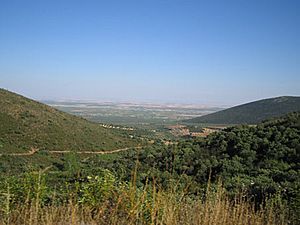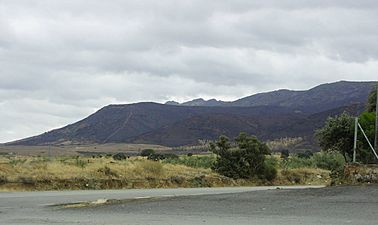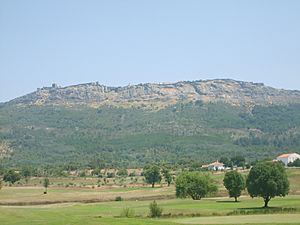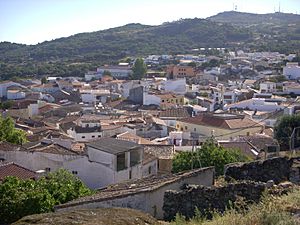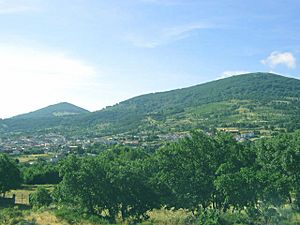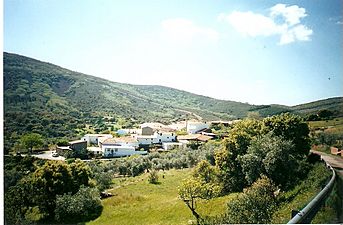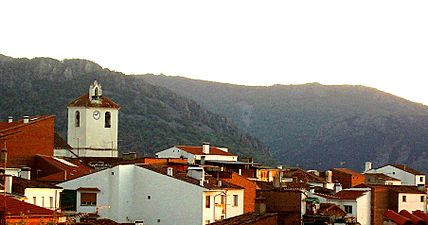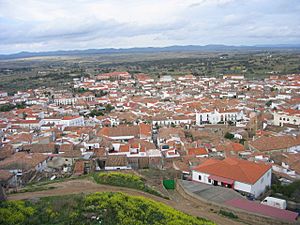Montes de Toledo facts for kids
Quick facts for kids Montes de Toledo |
|
|---|---|
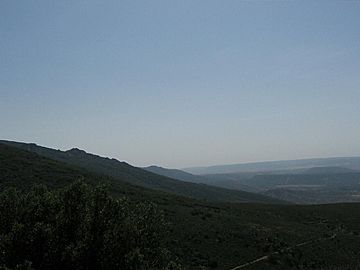
View of one of the eastern ranges in Cabañeros National Park
|
|
| Highest point | |
| Peak | La Villuerca |
| Elevation | 1,603 m (5,259 ft) |
| Dimensions | |
| Length | 350 km (220 mi) E/W |
| Width | 100 km (62 mi) N/S |
| Geography | |
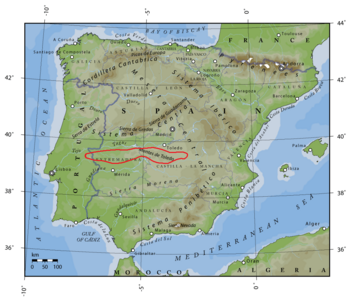
Location of the Montes de Toledo System in the Iberian Peninsula
|
|
| Countries | Spain and Portugal |
| Range coordinates | 39°23′0″N 4°29′30″W / 39.38333°N 4.49167°W |
| Geology | |
| Orogeny | Alpine |
| Age of rock | Tertiary |
| Type of rock | Sedimentary rock |
The Montes de Toledo are a major group of mountains in the Iberian Peninsula. They act like a natural wall, separating the river areas (called drainage basins) of the Tagus River and the Guadiana River. The tallest point in these mountains is La Villuerca, which stands at 1,603 meters (about 5,259 feet) high.
Contents
What are the Montes de Toledo?
The Montes de Toledo are located in the middle of the Iberian Peninsula. They stretch from east to west across the lower part of a large flat area called the Meseta Central. These mountains are about 350 kilometers (217 miles) long. At their widest point, near Sonseca and Puertollano, they can be up to 100 kilometers (62 miles) across.
The eastern parts of the Montes de Toledo form a natural border for the historic region of La Mancha in Castile-La Mancha, Spain. The western parts of these mountains reach all the way into the Portalegre District in Portugal.
How were these mountains formed?
The mountains in the Montes de Toledo system were created by a huge geological event called the Alpine Orogeny. This is the same process that formed many of the world's major mountain ranges. However, unlike the Central System to the north, the Montes de Toledo are made of older sedimentary rocks. These rocks have been folded and pushed together over a very long time. They have also been worn down a lot by weather and time.
The way the Montes de Toledo are built, geologically speaking, is similar to the Appalachian Mountains in North America. It's also like the Sierra Morena range, which is located further south in Spain.
Main Mountain Ranges
The Montes de Toledo system is made up of several different mountain ranges that stretch out from east to west. Here are some of the most important ones:
- Eastern Montes de Toledo: This is the part that gives the whole system its name. It's found in the southwestern part of Toledo Province and northwestern Ciudad Real Province. Some of the highest peaks here include Rocigalgo (1,447 meters or 4,747 feet) and Corral de Cantos (1,421 meters or 4,662 feet).
- A main range in this area is the Sierra de la Calderina. It includes smaller ranges like the Sierra de la Virgen (with Pico Alamillo at 1,213 meters or 3,979 feet), Sierra Luenga, and Sierra Arando.
- Sierra de Altamira: This range is located where Extremadura and Castilla-La Mancha meet. Its highest point is Riscos Altos (1,324 meters or 4,344 feet).
- Sierra del Hospital del Obispo: This range runs next to the Sierra de Altamira. Cervales, at 1,443 meters (4,734 feet), is its highest point.
- Sierra de Villuercas (or Sierra de Guadalupe): This range is in Extremadura and holds the highest peaks of the entire Montes de Toledo system. Besides La Villuerca (1,603 meters or 5,259 feet), other tall peaks are Carbonero (1,428 meters or 4,685 feet) and Ballesteros (1,342 meters or 4,403 feet).
- Sierra de Montánchez: Located in the central part of Cáceres Province, its highest point is Monte Viejo (995 meters or 3,264 feet).
- Sierra de San Pedro: This range is between Cáceres and Badajoz provinces. Its tallest peaks include Torrico de San Pedro (702 meters or 2,303 feet).
- Serra de São Mamede: This range is in Portugal, right next to Extremadura. It's the westernmost part of the Montes de Toledo. Its highest point is Pico de São Mamede (1,025 meters or 3,363 feet). The town of Marvão sits on top of a ridge in this range.
Amazing Views and Features
-
View of Sierra de Altamira near Carrascalejo
-
View of Marvão peak in Serra de São Mamede
-
Sierra de Montánchez above Montánchez town
-
San Pablo de los Montes village below the Sierra de San Pablo
-
Puerto de los Santos mountain pass across Sierra de la Calderina
-
Mountains above Robledillo village near Robledo del Mazo
-
View of Sierra de la Palomera above Castañar de Ibor
-
Sierra de Villuercas and Santa Lucia Dam
-
View of Alburquerque with the Sierra de San Pedro in the distance
Protected Natural Areas
To help protect the unique plants and animals of the Montes de Toledo, some areas have been made into parks:
- Cabañeros National Park
- Serra de São Mamede Natural Park
See also
 In Spanish: Montes de Toledo para niños
In Spanish: Montes de Toledo para niños
- Montes de Toledo Comarca
- La Jara
- Dehesa del Carrizal
- Geology of the Iberian Peninsula



